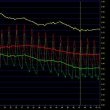Original Title: Should Transcatheter Aortic valve replacement Be Performed in Nonagenarians? Insights from the STS/ACC TVT Registry. Reference: Mani Arsalan et al. J Am Coll Cardiol. 2016 Mar 29;67(12):1387-95. Courtesy of Dr. Carlos Fava The benefit of the transcatheter aortic valve replacement (TAVI) has already been shown in the general population undergoing this procedure. The number<a href="https://solaci.org/en/2016/04/12/tavi-in-%e2%89%a590-year-old-patients-as-beneficial-as-in-younger-patients/" title="Read more" >...</a>
In Bifurcations, less is more, also at long term
Original Title: Optimal Strategy for Provisional Side Branch Intervention in Coronary Bifurcation Lesions3-Year Outcomes of the SMART-STRATEGY Randomized Trial. Reference: Young Bin Song et al. J Am CollCardiolIntv. 2016;9(6):517-526. This study compared the long term outcomes of the conservative strategy vs. the aggressive strategy for provisional side branch intervention in coronary bifurcations. It has already<a href="https://solaci.org/en/2016/03/27/in-bifurcations-less-is-more-also-at-long-term/" title="Read more" >...</a>
The largest series with LOTUS Valve published so far
This work represents the UK experience with the second generation repositionable and retrievable valve Lotus (Boston Scientific, Natick, Massachusetts). It prospectively included 228 patients of mean age 81.4 ± 7.6 and a logistic EuroScore of 17.5 ± 12.4. From the total number of patients, 187 (82%) received the valve for aortic stenosis, 7<a href="https://solaci.org/en/2016/03/08/the-largest-series-with-lotus-valve-published-so-far/" title="Read more" >...</a>
Impact of the Right Atrial Pressure on FFR measurement
Original Title: Impact of the Right Atrial Pressure on Fractional Flow Reserve Measurements Comparison of Fractional flow Reserve and Myocardial Fractional flow Reserve in 1600 Coronary Stenosis. Reference: Toth G, et al. JACC Cardiovasc Interv. 2016 Feb 12. Epub ahead of print. Courtesy of Dr. Guillermo Migliaro. Fractional Flow Reserve (FFR) is the gold standard for the<a href="https://solaci.org/en/2016/02/29/impact-of-the-right-atrial-pressure-on-ffr-measurement/" title="Read more" >...</a>
Meta-Analysis of Bioresorbable Vascular Scaffolds vs. Everolimus Eluting Stents
Courtesy of Dr. Agustín Vecchia. The aim of this study was to compare the safety and efficacy of bioresorbable everolimus eluting scaffolds (BVS) vs. everolimus eluting stents (EES) in patients with ischemic heart disease. Medline, Embase, the Cochrane Central Register of Controlled Trials (CENTRAL), was searched for scientific sessions, abstracts, and relevant websites for<a href="https://solaci.org/en/2016/01/19/meta-analysis-of-bioresorbable-vascular-scaffolds-vs-everolimus-eluting-stents/" title="Read more" >...</a>
ABSORB III: Everolimus Eluting Bioresorbable Scaffolds for Coronary Artery Disease
Original Title: Everolimus-Eluting Bioresorbable Scaffolds for Coronary Artery Disease. Reference: Stone, M.D. for the ABSORB III Investigators. N Engl J Med 2015;373:1905-1915. The ABSORB III is part of a series of randomized studies that test bioresorbable scaffolds in the clinical practice (ABSORB II, EVERBIO II, ABSORB Japan, and ABSORB IV). 2008 patients were randomized; 60% had<a href="https://solaci.org/en/2015/11/20/absorb-iii-everolimus-eluting-bioresorbable-scaffolds-for-coronary-artery-disease/" title="Read more" >...</a>
INHERIT: Losartan in hypertrophic cardiomyopathy
Hypertrophic cardiomyopathy is the most common hereditary cardiac pathology (1/1500) and is associated to heart failure, angina, arrhythmia, and sudden death. So far, no treatment has been proved effective to control this disease. This study randomized 133 patients with hypertrophic cardiomyopathy to placebo or losartan. Primary end point was change in left ventricular (LV) mass.<a href="https://solaci.org/en/2015/06/24/inherit-losartan-in-hypertrophic-cardiomyopathy/" title="Read more" >...</a>
Coronary flow reserve is associated to adverse events regardless angiographic severity.
This study included 329 consecutive patients derived to coronary angiography based on myocardial perfusion tests or PET scan (positron emission tomography). The extension and severity of heart disease was assessed by angiography, and coronary flow reserve (CFR) was measured non-invasively by PET. After adjusting risk factors, ejection fraction, revascularization, etc, both the severity of angiographic<a href="https://solaci.org/en/2015/06/24/coronary-flow-reserve-is-associated-to-adverse-events-regardless-angiographic-severity/" title="Read more" >...</a>
ANTHEM-HF: autonomic regulation to improve ventricular function
In the context of heart failure, there is an autonomic imbalance characterized by increased sympathetic activity and decreased parasympathetic activity. This autonomic imbalance may contribute to the progression of heart failure symptoms. Preclinical studies showed benefits with vagal stimulation. The aim of this work was to demonstrate the safety and efficacy of the therapy system<a href="https://solaci.org/en/2015/06/24/anthem-hf-autonomic-regulation-to-improve-ventricular-function/" title="Read more" >...</a>
AIDA STEMI MRI: Intracoronary versus intravenous abciximab in primary angioplasty. MRI analysis in AIDA study
Basics: Recent meta-analysis showed benefits of intracoronary abciximab administration compared with intravenous (A-EV). Although the AIDA study showed no such benefit when analyzing the combined endpoints of death, reinfarction and congestive heart failure, it did show a decrease of CHF in isolation over the group receiving intracoronary abciximab. This time, the study authors of AIDA<a href="https://solaci.org/en/2015/06/24/aida-stemi-mri-intracoronary-versus-intravenous-abciximab-in-primary-angioplasty-mri-analysis-in-aida-study/" title="Read more" >...</a>









